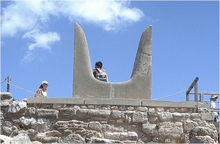Horns of Consecration
"Horns of Consecration" is an expression coined by Sir Arthur Evans[1] to describe the symbol, ubiquitous in Minoan civilization, that represents the horns of the sacred bull: Sir Arthur Evans concluded, after noting numerous examples in Minoan and Mycenaean contexts, that the Horns of Consecration were "a more or less conventionalised article of ritual furniture derived from the actual horns of the sacrificial oxen"[2] The much-photographed porous limestone horns of consecration on the East Propyleia at Knossos (illustration, right) are restorations, but horns of consecration in stone or clay were placed on the roofs of buildings in Neopalatial Crete, or on tombs or shrines, probably as signs of sanctity of the structure.[3] The symbol also appears on Minoan seals,[4] often accompanied by double axes and bucrania, which are part of the iconography of Minoan bull sacrifice. Horns of consecration are among the cultic images painted on the Minoan coffins called larnakes, sometimes in isolation; they may have flowers between the horns, or the labrys.[5]

See also
Notes
- E..g. in Evans, "Mycenaean tree- and pillar-cult and its Mediterranean relations", The Journal of Hellenic Studies 31 (1901) pp 107, 135-38, "§15- The Horns of Consecration".
- Evans 1901:137; horns of consecration are juxtaposed with bulls in many configurations on Late Minoan IIIA2 larnakes illustrated by L. Vance Watrous, "The Origin and Iconography of the Late Minoan Painted Larnax" Hesperia 6.3 (July 1991), pp 285-307).
- Geraldine C. Gesell, Town, Palace, and House Cult in Minoan Crete (SIMA, Göthenburg) 1985, p. 62.
- An example is the seal illustrated by Evans, "The Palace of Knossos", BSA 7 (1900/01), fig. 9 and as fig. 1 in Karl Kerenyi, Dionysos: Archetypal Image of Indestructible Life (Princeton) 1976, and by Joseph Campbell, Occidental Mythology: The Masks of God (1964) 1970, fig. 12..
- Watrous 1991, passim.